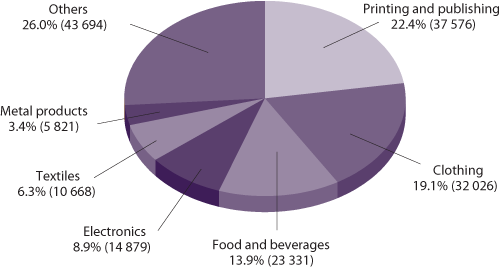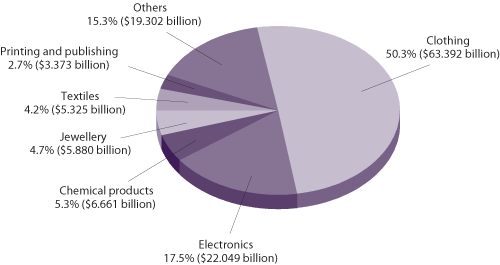With continued growth in the Mainland economy
and a visible pick-up in the global economy, Hong Kong was witness
to a notable growth in external trade in 2004. Total merchandise
trade increased by 16.4 per cent to $4,130.2 billion. Domestic exports
increased by 3.5 per cent to $126 billion, while re-exports rose
by 16.8 per cent to $1,893.1 billion. Imports increased by 16.9
per cent to $2,111.1 billion. The year recorded a trade deficit
of $92 billion, greater than the corresponding deficit of $63.4
billion in 2003. The Appendices provide summary statistics of external
trade.
In 2004, Hong Kong's largest trading partners
were the Mainland of China (the Mainland), followed by the United
States of America (USA) and Japan.
In 2004, Hong Kong was the world's 11th largest
trading entity in terms of value of merchandise trade.
Imports
Imports of raw materials and semi-manufactures,
at $805.2 billion in 2004, constituted the largest share of total
imports. This was followed by consumer goods ($631.8 billion), capital
goods ($565.4 billion), foodstuffs ($60.1 billion) and fuels ($48.6
billion).
In 2004, the Mainland, Japan and Taiwan were Hong
Kong's major suppliers, accounting for 43.5 per cent, 12.1 per cent
and 7.3 per cent of the total value of imports, respectively.
Domestic Exports
Articles of apparel and clothing accessories continued
to be the largest component of domestic exports, valued at $63.4
billion or 50.3 per cent of the total value of domestic exports
in 2004. At $13.1 billion, electrical machinery, apparatus and appliances,
and electrical parts thereof came second. Other major export items
included jewellery, goldsmiths' and silversmiths' wares, and other
articles of precious or semi-precious materials; textile yarn, fabrics,
made-up articles and related products; office machines and automatic
data processing machines; and plastics in primary form.
In 2004, the USA, the Mainland and the United
Kingdom were Hong Kong's largest markets, absorbing 30.7 per cent,
30.1 per cent and 6.5 per cent of the total value of domestic exports,
respectively.
Re-exports
In 2004, principal commodities re-exported were
electrical machinery, apparatus and appliances, and electrical parts
thereof ($383.8 billion or 20.3 per cent of the total value of re-exports),
as well as telecommunications and sound recording and reproducing
apparatus and equipment ($286.6 billion or 15.1 per cent of the
total value of re-exports). The Mainland, Japan and Taiwan were
the main origins of the re-exports, while the Mainland, the USA
and Japan were the main destinations.
The Manufacturing
Sector
Innovation, technology and relocation of lower
value-added operations to the Mainland have accelerated the development
of more knowledge-based and higher value-added manufacturing activities,
as well as manufacturing-related services or producer services.
Expansion of manufacturing activities offshore since the 1980s has
turned Hong Kong into a strategic control centre of an increasingly
globalised production network. In spite of Hong Kong's economic
restructuring, the manufacturing sector remained an important sector
of the economy, providing employment to 165 300 persons (7.2
per cent of all private sector employees) in December 2004.
The printing and publishing industry was the largest
employer in the manufacturing sector as at September 2004, followed
by the clothing industry. Chart 1 shows the breakdown of
employment within the manufacturing sector as at September 2004.
| Chart 1 |
| Number of Persons
Employed by the Manufacturing Sector as |
| at September 2004 |
 |
The manufacturing sector remains export-oriented
and its excellent performance contributed to Hong Kong's ranking
as one of the world's leading exporters of textiles, clothing, watches
and clocks, toys and jewellery. Domestic exports amounted to $126
billion in 2004 with clothing, electronics, chemical products, jewellery
and textiles being the major export items. Chart 2 shows
the value breakdown of domestic exports in 2004.
| Chart 2: |
| Value of Domestic Exports
of the Manufacturing Sector in 2004 |
| |
 |
The manufacturing sector is dominated by SMEs.
Of the 15 750 manufacturing establishments in 2004, 15 530
(98.6 per cent) employed fewer than 100 persons, accounting for
62 per cent of Hong Kong's total manufacturing employment. Many
SMEs are linked with larger factories through an efficient and flexible
sub-contracting network. This arrangement has enabled the manufacturing
sector to respond swiftly to market changes.
|